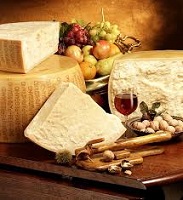Swedish cheese is renowned to be the best quality cheese. Read our guide below for more facts and information on cheese varieties from Sweden…
Swedish cheese is of many varieties with lovely variants. Some of the famous types of Swedish cheese produced are as follows:
Bla Gotland
This cheese was produced in Sweden by Arla Foods Company on the island of Gotland in Stanza town. This is considered between mild and strong having elements of both. It is pale in color, having no holes. Its texture is like Emmentaler but has a strong flavor. It is cube-shaped and is placed in blue wax.
Herrgardsost
This cheese is made of cow’s milk. It was first made in 1890 and is popular in Sweden. It has a mild, nutty and sweet flavor with small round holes. It is made from pasteurized part-skimmed milk. Bacteria are introduced in milk which produces carbon dioxide and creates holes. The milk is curdled and heated up to 43 degrees Celsius. Curd is pressed making a hole which is salted. Cheese wheels are wax coated after two weeks. They are preserved for three to four months.
Hushallsost
It is semi-hard cheese having small granular holes. It is made of Swedish whole cow milk having 24% fat content. It is made in cylinders weighing up to two kilograms and is covered in film of plastic before aging for 60 days. It tastes mild and sour.
Prastost
This Swedish cheese was earlier produced in churches in Sweden and is now made in factory from pasteurized milk of cow. It is soaked in whiskey or saaland pfarr, another type of whisky used for this purpose. A portion of it is preserved for 12 months. It is then cured in vodka. The manufacturing technique is known as Prastost.
Svecia
It is semi-hard Swedish cheese made of cow’s milk which is light yellowish, has small and irregular holes and is slightly acidic in taste. This is made in wax-covered cylinders which weigh 12-15 kilograms. For making it, milk is pasteurized to 72 degrees Celsius and then cooled to 30 degrees Celsius. For coagulating milk into curds, rennet is mixed and lactic acid enzymes are used to replace enzymes. Bacteria are killed during pasteurization. After cutting curd, it is stirred and drained slowly and again heated up to 40 degrees to drain out moisture. After adding salt, curds are packed in moulds slightly loosely to leave air pockets that make Svecia’s small holes. After soaking in brine to reduce salt content to 1.5% of weight, it is preserved for two months in a dry environment.
Vasterbotten
It is hard cow’s milk cheese having tiny holes and granular texture. After heating, it is cut and stirred at the time of molding and ageing. It has strong flavor and tastes salty and bitter. Slightly yellowish, it has 31% fat content. It is considered the king of all cheeses and is in great demand but is twice as expensive as many other cheese varieties.





